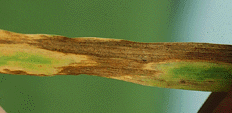Septoria Leaf Blotch Complex in Wheat
Leaf Blotch Complex
Symptoms

Septoria tritici on wheat
University of Kentucky Dept. Plant Pathology
The leaf blotch complex is caused by two distinct fungi, Septoria tritici and Stagonospora nodorum. The fungi may occur individually in a crop or at the same time, even on the same leaves.
Lesions caused by Septoria tritici infection are brown, elongated rectangular lesions with irregular margins. Lesions have numerous black pin-point specks throughout. These are spore-producing structures called pycnidia. Septoria tritici pycnidia are visible with the naked eye. Pycnidia will be most evident in the morning following a heavy dew, or after rain. Symptoms usually appear in the lower leaves and move upward.
Lesions caused by Stagonospora nodorum tend to be more lens-shaped, and usually a have distinct yellow halo around each lesion. Light brown pycnidia are present in the lesions but are difficult to see without the aid of a magnifying lens while holding the leaves up to light. S. nodorum infections can occur very early in the season, but are most evident just prior to and after heading. Starting in the lower leaves, infections move to the upper leaves and heads, causing Glume Blotch.
Cause
Septoria and Stagonospora fungi overwinter in wheat stubble of previously diseased crops or on infested seed. Spores are produced during wet weather in the fall and spring, but spring infections, especially during crop heading cause the greatest yield damage. Infection by S. tritici is very temperature-dependent and is greatest during cool to moderate temperatures and abundant moisture. Infection by S. nodorum can occur over a wide range of temperature, but is favored in the mid- to late stages of crop development when plants are most susceptible to infection.
IPM Techniques
- Crop rotation in which wheat or other cereals appear no more than once every third year will reduce the amount of residue in the field that may harbor the fungi.
- Plowing under wheat residue after wheat harvest or following harvest of double-crop soybeans can help speed the decomposition of residue and limit the dispersal of fungal spores from the residue before it decomposes.
- Plant moderately resistant varieties.
- Plant high-quality, well-cleaned, disease free seed (e.g. certified seed).
- Avoid excessive seeding rates, as well as nitrogen deficiencies and excesses.
- Limiting canopy density will increase air circulation and light penetration into the crop, allowing leaves to dry faster and providing less favorable conditions for fungal infection.
References and Additional Information
- IPM-4 Kentucky IPM Manual for Small Grains
- PPA-10c Kentucky Plan Disease Management Guide for Small Grains by D.E. Hershman and Paul Vincelli
- PPA-39 Septoria Diseases of Wheat by Donald E. Hershman
- PPA-36 Fungicides to Control Leaf Diseases in High Yield Wheat
- Foliar Fungicide Use in Wheat, Grain Gleanings, Vol.1, No. 3 (1993)
- Annual Kentucky Small Grain Variety Trials, Progress Report 355
- Selecting Wheat Varieties, Grain Gleanings, Vol. 1, No. 9 (1993)
- Common Diseases of Small Grain Cereals. F. J. International Maize and Wheat Improvement Center, Londres 40, Apdo. Postal 6-641, Mexico, D.F., Mexico
- Compendium of Wheat Diseases, M.V. Wiese, The American Phytopathological Society Press, 1987.


